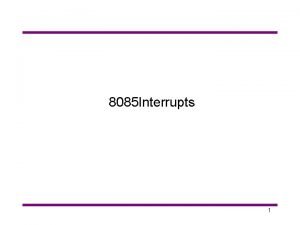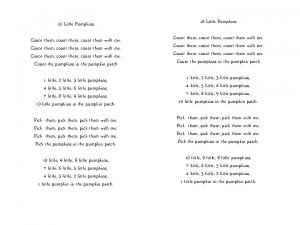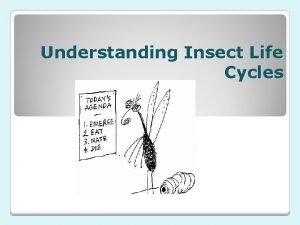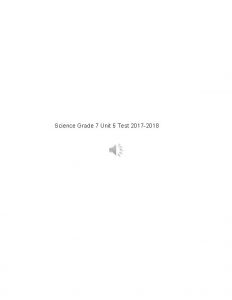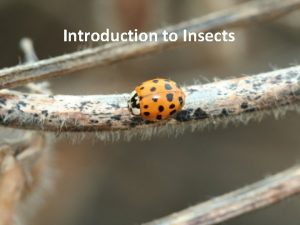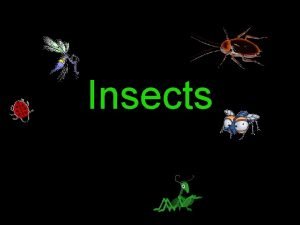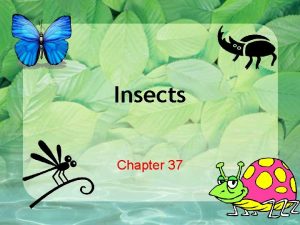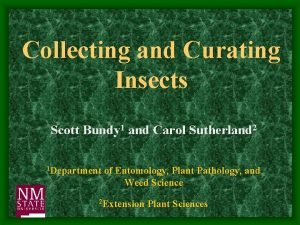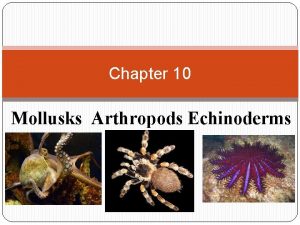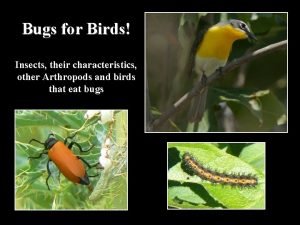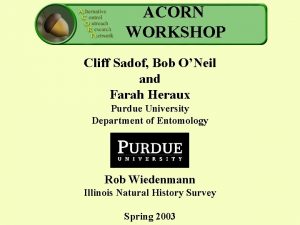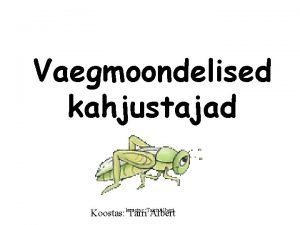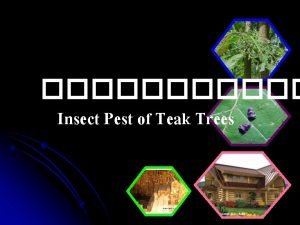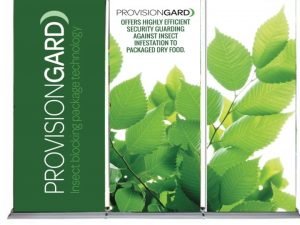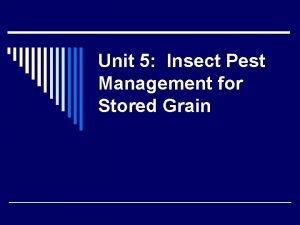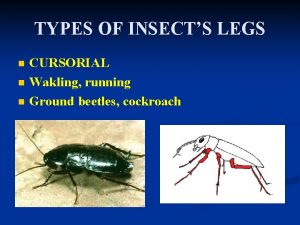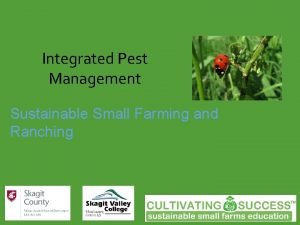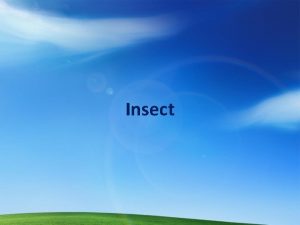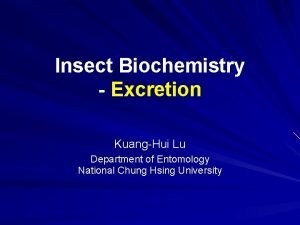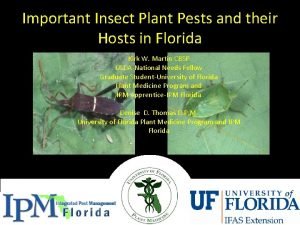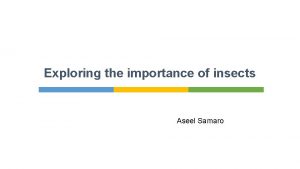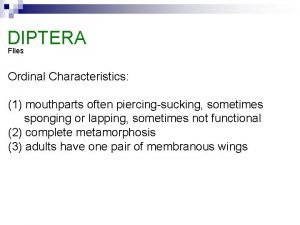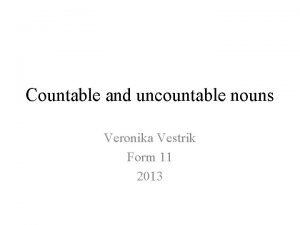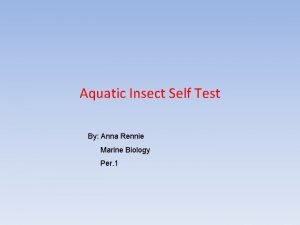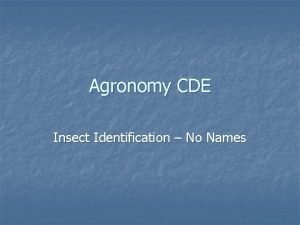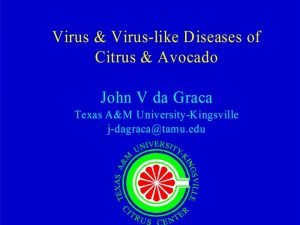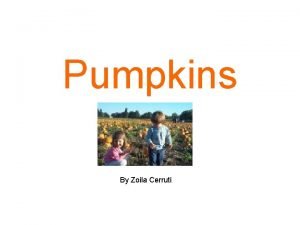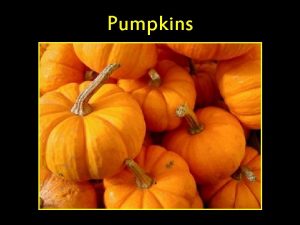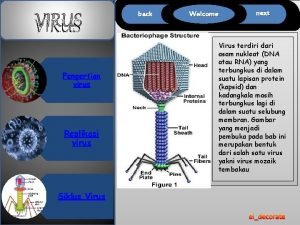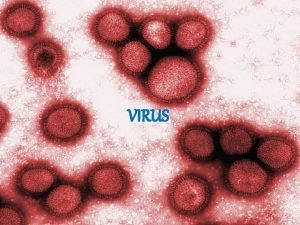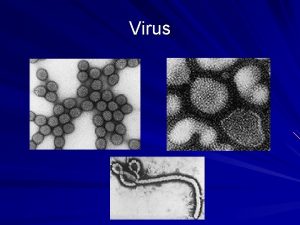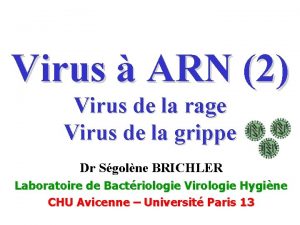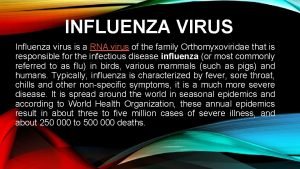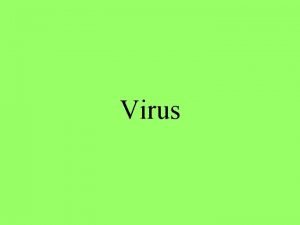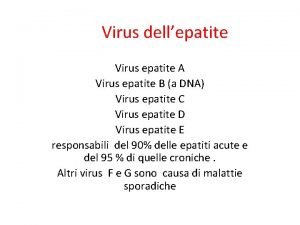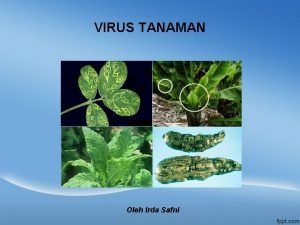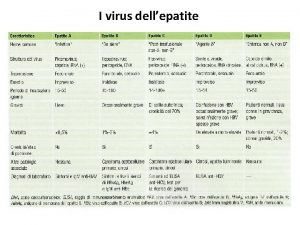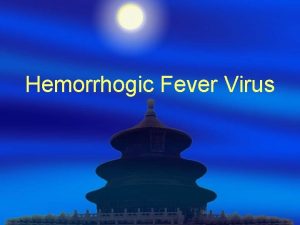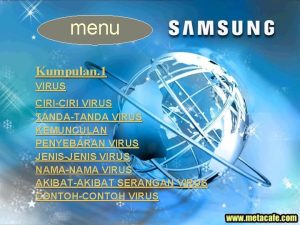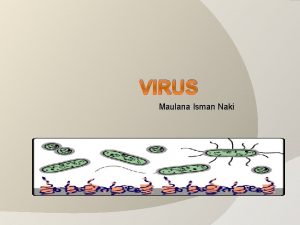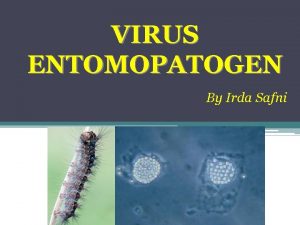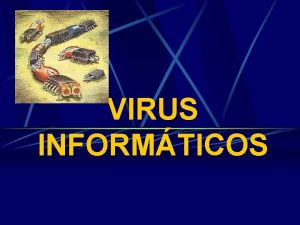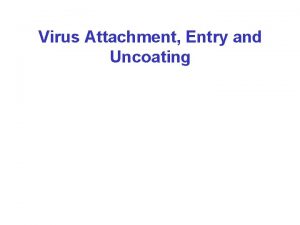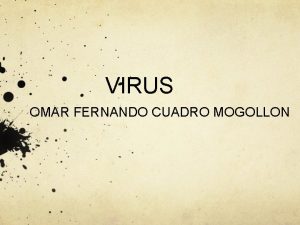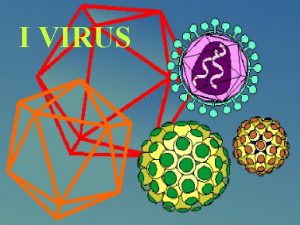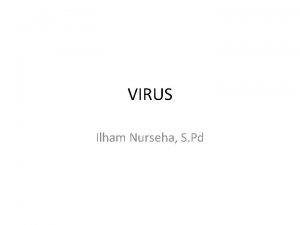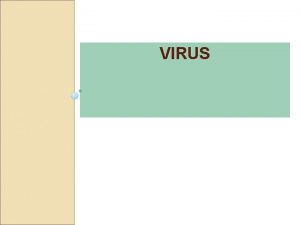Management of insect vectored virus diseases pumpkins January




































- Slides: 36

Management of insect vectored virus diseases - pumpkins January 28, 2020, Wisconsin Dells, WI Russell L. Groves Department of Entomology, University of Wisconsin, Madison, WI 53706 groves@entomology. wisc. edu

Presentation Outline • Fundamentals of pathogen spread by insects (definitions) - association with insects (circulative, propagative) - transmission types (non-persistent, semi-persistent, persistent) - patterns of spread (primary vs secondary) - insect movement and colonization • Managing the problem (approach) - varietal selection - sanitation and inoculum source reduction - precise timing of crop protectants Photo credit. Gerald Holmes

Insect – Vectored, Plant Disease Epidemiology Spread of Plant Pathogens by Insects Involves Interactions of Plant Pathogen Insect Vector Environment weather cultural practices farming operations agroecosystem Plant Disease

Vector-Transmitted Diseases: Disease Triangle Disease Quadrangle Susceptible Host Competent Vector No Disease Ecology is the study of the relationships between living organisms, including humans, and their physical No Disease and the world around them environment; it seeks to understand the vital connections between plants and animals No Disease Pathogen No Disease Environment

Pest management tactics for vegetable insects Integration of available tools to manage pest damage in the most economically, socially, and environmentally sound way Host plant resistance Cultural controls Natural enemies Baits and baiting systems Transgenic plants Vegetable IPM Reduced-Risk Insecticides Entomopathogens Population disruption

Insect – Vectored, Plant Disease Ecology Spread of Plant Pathogens by Insects Involves Interactions of Plant Pathogen Insect Vector Environment weather cultural practices farming operations agroecosystem Plant Disease whiteflies thrips aphids leafhoppers

Several non-persistently transmitted viruses • Cucumber mosaic virus (CMV) – Bromoviridae (Cucumovirus) • Watermelon mosaic virus (WMV-1) – Potyviridae (Potyvirus) • Papaya ringspot virus (PRSV-W) – Potyviridae (Potyvirus) - Symptoms similar across many viruses - Time of infection important http: //news. monsanto. com/image/infographic/role-data-science-agriculture - Aphid vectors - Mixed infections • Squash mosaic virus (Sq. MV) – Secoviridae (Comovirus) - Beetle transmitted (striped / spotted cucumber beetle)

CMV – Cucumber mosaic virus http: //news. monsanto. com/image/infographic/role-data-science-agriculture

Watermelon mosaic virus - WMV http: //news. monsanto. com/image/infographic/role-data-science-agriculture

Papaya ringspot virus – PRSV-W http: //news. monsanto. com/image/infographic/role-data-science-agriculture Papaya ringspot virus

Squash mosaic virus - Sq. MV http: //news. monsanto. com/image/infographic/role-data-science-agriculture

Types of Pathogen Interactions with Insects Circulative (PLRV, AYp, TSWV) Systemic movement within insect body Haemocoel Hindgut Midgut PSG ASG Salivary Canal Phloem Propagative Pathogen replication within insect body (transovariol) Food Canal

Types of Pathogen Interactions with Insects Non-circulative (PVY, CMV, AMV) often referred to as “stylet-borne” Haemocoel Hindgut Midgut PSG ASG Salivary Canal Phloem Food Canal

Non-Circulative Pathogen Movement in Insects Food Ingestion - pathogen particles attach to maxillary lumen Ingestion Egestion - pathogen particles released with saliva Salivation

Types of Pathogen Transmission by Insects Non-persistent often referred to as “stylet-borne” Persistent Variations include circulative, propagative, transovariol Semi-persistent

Non-persistent Transmission Acquisition time - time required to acquire pathogen Seconds Inoculation time - time required by infectious insect to inoculate a susceptible host Seconds Latent period - (minimum time between acquisition of a pathogen and ability to transmit) Zero Retention time - time after acquisition that a vector remains capable of transmitting the virus Minutes to hours

Persistent Transmission Acquisition time - minutes Inoculation time – minutes Positive correlation between feeding time and probability of acquisition and of inoculation Latent period - several days virus must move from gut to salivary gland virus may replicate in insect Retention time - through molt, often for life of insect Vector specificity - high

Semi-persistent Transmission Acquisition time - minutes Inoculation time – minutes Positive correlation between feeding time and probability of acquisition and of inoculation Latent period - zero transmission immediately following acquisition pathogen may replicate in vector Retention time - hours to days not retained through molt Vector specificity - some

Categories of Vector Residence Transient vectors - do not colonize the crop to which they spread virus - most important for non-persistent viruses - relatively unimportant for persistent viruses Rhopalosiphum padi Resident vectors - colonize the crop to which they spread virus - can be important for all types of transmission - most important for persistent viruses Myzus persicae

Traps for Determining Transient Vectors water pan trap green and yellow sticky tile traps • Resident vectors are evaluated through visual inspection and associated offspring

Categories of Insect Dispersal Trivial flights - random movement among selected hosts - important for secondary spread - important for non-persistent viruses Insect migration - long distance obligatory flights - can be important for all types of transmission

Host selection and alightment by aphids • • • Migrating aphids ready to land are attracted to yellow/green and repelled by UV Landing on plants is usually edge-distributed, but generally random Suitability of plant determined by briefly probing the plant with mouth parts, or stylets (tasting) - Small proportion of aphids remain on 1 st suitable host plant encountered - Subsequent flights of aphids that leave a suitable plant are relatively short ‘trivial’

Reflective Mulch for Aphid/Virus Management Theory: Repels winged aphids (reflected UV) Delays aphid colonization Delays virus infection

Categories of Pathogen Spread • Primary spread: - Initial spread of pathogen into a field from sources outside field • Secondary spread: - Spread of pathogen within a field from sources of virus within the same field

Presentation Outline • Fundamentals of pathogen spread by insects (definitions) - association with insects (circulative, propagative) - transmission types (non-persistent, semi-persistent, persistent) - patterns of spread (primary vs secondary) - insect movement and colonization • Managing the problem (approach) - varietal selection - sanitation and inoculum source reduction - precise timing of crop protectants Photo credit. Gerald Holmes

Key Determinants of Virus Spread • Amount of virus inoculum in area (initial inoculum) • Location of virus inoculum relative to crop (outside/inside) • Susceptibility of crop to virus infection (cultivar variation ) • Vectors - number of species (relative abundance in landscape) - transmission efficiency of vectors - abundance of individuals - activity of vector • level and timing • Environmental conditions (wind, RH, temp)

General Approaches to Management of Aphid-borne Plant Viruses • Host manipulation (isolation in space and time), host tolerance (planting dates, variety selection) • Reducing virus sources (inoculum id and reduction) • Manipulating (controlling) vectors (alightment, landing, plant apparency) • Blocking virus transfer between aphid & plant (oils, insecticides, transgenics)

Resistance to virus infection Cornel Disease Resistant Cultivars http: //vegetablemdonline. ppath. cornell. edu/Tables/Table. List. htm

Insect – Sampling and thresholds (foliar) Sampling • Yellow sticky cards • Plant counts • Colonization times critical Action thresholds • 1 beetle/plant for melons, cucumbers, and young pumpkins • 5 beetles/plant for watermelon, squash, and older pumpkins

Reducing sources of inoculum Weed management Cover cropping / no till

Sanitation – weed management and exclusion Cultural • Eliminate weeds, weedy edges (non-crop sanitation) • Crop rotation • Early season row cover Row cover Close mowing

Seasonal Dispersal - Suction Trap Network Ø Weekly captures of dispersing aphid species. Ø Dr. David Voegtlin, Illinois Natural History Survey Acyrthosiphon pisum Aphis craccivora Aphis glycines Aphis gossypii Aphis helianthi Aphis nasturtii Aphis spiraecola Brachycaudus helichrysi Lipaphis pseudobrassicae Macrosiphum euphorbiae Myzus persicae Rhopalosiphum insertum Rhopalosiphum maidis Rhopalosiphum padi Schizaphis graminum Sitobion avenae Therioaphis trifolii "Pea aphid" "Black legume aphid" "Soybean aphid" "Cotton- melon aphid" "Sunflower or dogwood aphid" "Buckthorn - potato aphid" "Spiraea aphid" "Leaf curling plum aphid" "Turnip aphid" "Potato aphid" "Peach potato aphid" "Apple grass aphid" "Corn leaf aphid" "Bird cherry-oat aphid" "Greenbug" "English grain aphid" "Spotted Alfalfa aphid"

Managing virus spread: Multi-tactic Approach • Early grain aphid migrations (mid-June) • Colonizing aphids and mass flights (late July – early August) http: //news. monsanto. com/image/infographic/role-data-science-agriculture

Aphid control options: Cucurbits / aphids Mode of Action Class (Group)a Active Ingredient Application / Deliveryb Trade Names Registration Status imidaclopridc Admire Pro®, Gaucho®, Provado® thiamethoxam Platinum®, Cruiser®, Actara® clothianadin Belay® dinotefuran Scorpion™ F Registered acetampirid Assail® F Registered sulfoxaflor Transform® F Registered (2012) pymetrozine Fulfill® F Registered flonicamid Beleaf® F Registered Narrow-range mineral and paraffinic oils (UN) petroleum oil Aphoil™, JMS Stylet oil® F Registered Terpene constituents (C. album) (UN) terpene Requiem® F Registered (2010) Inhibitors of acetyl Co. A carboxylase (23) spirotetramat Movento® F Registered (2011) Ryanodine receptor modulators (28) cyazypyr Verimark™, Exirel™ IF, F Registered (2015) Nicotinic acetylcholine receptor (n. ACh. R) agonists (4 A & 4 C) IF, ST, F, SD Registered http: //news. monsanto. com/image/infographic/role-data-science-agriculture Selective Homopteran feeding blockers (9 B & 9 C) a Insecticide Resistance Action Committee (http: //www. irac-online. org) Application types include: in-furrow (IF), seed treatment (ST), foliar (F) and side-dress (SD) c Several generic formulations exist b

Virus Management Summary. Season Minimizing Current Infection: Foliar Protectant Summary ØApproaches to limit aphid landing / alightment ØSelection of cultivars with stated resistance to virus infection ØSanitation of weedy hosts supporting both the vector (aphids) and the virus (weedy inoculum) ØImproved understanding of the timing of disease spread and relationship to regional, primary insect vectors – A. glycines, R. padi, etc… Ø Weekly oil applications of mineral oil or feeding deterrent insecticides.

Acknowledgements People & Associations • Wisconsin Fresh Fruit and Vegetable Growers Association • Wisconsin Seed Certification Program: Alex Crockford, Kevin Bula, Dianna Kessler, Clover Spacek, James Meyer, Jolene Spurgeon, Wisconsin Seed Potato Producers • Wisconsin Seed Potato Industry Association • Wisconsin Potato Industry Board http: //labs. russell. wisc. edu/vegento/
 Interrupt in microprocessor
Interrupt in microprocessor 10 little pumpkins
10 little pumpkins Coffee new world or old world
Coffee new world or old world How many pumpkins do you see
How many pumpkins do you see Analyzing one variable data
Analyzing one variable data Dermaptera metamorphosis
Dermaptera metamorphosis A student examines the winged insect shown below
A student examines the winged insect shown below Sponging type of mouth parts present in
Sponging type of mouth parts present in Saprophore
Saprophore What is the middle part of an insect's body called
What is the middle part of an insect's body called Section 37-2 review insect behavior
Section 37-2 review insect behavior Insect point punch
Insect point punch Mollusks arthropods and echinoderms
Mollusks arthropods and echinoderms Characteristics of an insect
Characteristics of an insect Silly farah insect
Silly farah insect Lecanium corni
Lecanium corni Extemporaneous compounding recipes
Extemporaneous compounding recipes Spider is an insect true or false
Spider is an insect true or false Teak insect
Teak insect Shifters of supply
Shifters of supply Packaging
Packaging Grain insect
Grain insect Cursorial legs insects
Cursorial legs insects Predatorsl
Predatorsl Insect
Insect Insect resurgence
Insect resurgence Hemimetabolous metamorphosis
Hemimetabolous metamorphosis Malpighian tubules
Malpighian tubules Podos greek
Podos greek Insect egg
Insect egg Insect
Insect A bird stalks kills and then eats an insect
A bird stalks kills and then eats an insect Order diptera characteristics
Order diptera characteristics Electricity countable or uncountable
Electricity countable or uncountable Whirlwig rennie
Whirlwig rennie Insect identification
Insect identification Insect foot
Insect foot
